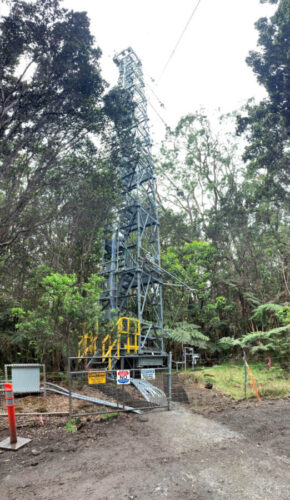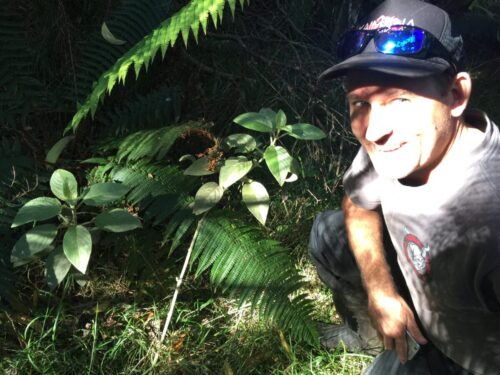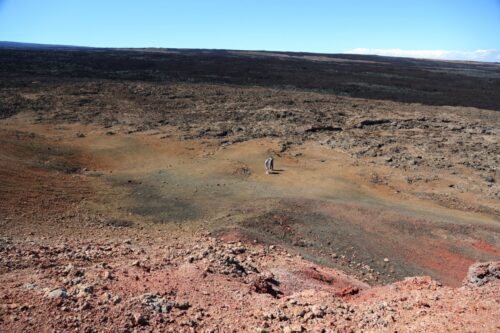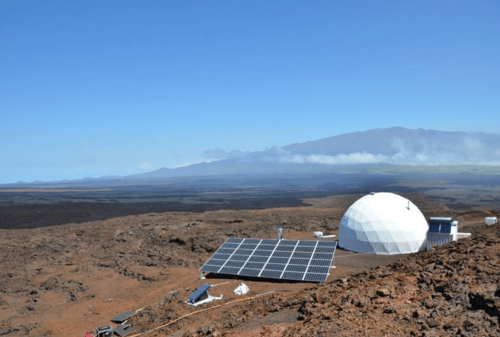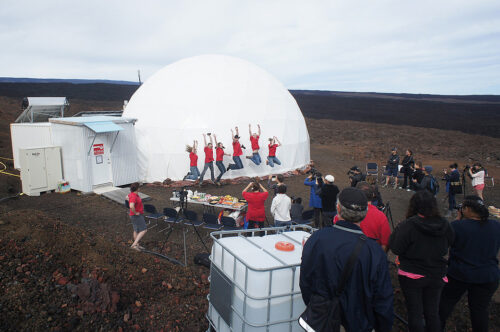Geometrician often works to assist high tech scientists in conducting environmental analysis and permitting to allow their experiments to take place in sensitive environments. Geometrician was hired to assess one of the most delicate habitats in Hawai‘i prior to installation of the Pu‘u Maka‘ala Natural Area Reserve Site for the National Ecological Observatory Network (NEON) Project. NEON is a continental‐scale ecological observation facility sponsored by the National Science Foundation (NSF) and operated by Battelle Memorial Institute (Battelle). NEON gathers and synthesizes data to study impacts of climate change, land use change, and invasive species on natural resources and biodiversity. NEON data is also used by the `Alalā Project, which is restoring Hawai‘i’s native crow species to the wild. The NEON observatory is a 105-foot tall guyed tower with millions of dollars of meteorological and remote sensing instruments set amid a pristine forest, at the edge of an unpaved road. The goal was to observe the ecosystem in action but not affect it in any way. Dr. Terry worked with Associates Dr. Jonathan Price and Dr. Patrick Hart of UH Hilo in 2018 to ensure that the NEON footprint avoided rare, threatened or endangered species.
Two other fascinating projects involved the out-of-this-world landscape of the Saddle between Mauna Kea and Mauna Loa – and both involved space research. In 2013, Geometrician prepared an Environmental Assessment and assisted in a Conservation District Use Permit for Dr. Kim Binsted of the University of Hawai‘i and the Pacific International Space Center for Exploration Systems (PISCES). The project was to permit establishment of the HI-SEAS (Hawai’i Space Exploration Analog and Simulation), a habitat on an isolated Mars-like setting at approximately 8200 feet above sea level off the Mauna Loa Observatory Road. This unique habitat allows scientists to study how crews perform long-term in a Mars-like environment while conducting tasks such as geological field work. The conditions of the habitat, the mission, and communications painstakingly simulate those expected on a real planetary exploration mission. Geometrician’s work involved botanical and entomological survey and an assessment of the visual impacts of the facilities, as well as coordinating archaeological and cultural surveys. The multi-month experiments have attracted world-wide attention (and even notoriety) and are often likened to a “real” reality show.
NASA scientists studying satellite imagery in 1996 found that the Saddle region of the Big Island had unique altered ash deposits, called palagonitized tephra, which very closely resemble loose material on Mars. Scientists and engineers studying Mars require materials that can be used as simulants for the surface of that planet for experiments on vehicular rover performance, food production, and equipment maintenance. This deeply-weathered volcanic ash is found as a narrow layer beneath the surface. Dr. John P. (“Jack”) Lockwood of Volcano was contacted in 1996 to see if small quantities of this ash could be extracted and processed for use in NASA experiments. The trial was successful, and when larger quantities of ash were needed, Dr. Lockwood asked Geometrician Associates for assistance with an Environmental Assessment and Conservation District Use Permit. The chosen site was Pu‘u Nene, near the old Saddle Road at Humu‘ula. Although the hill had a long history of major quarrying, and the Mars Ash project only required a small area to be disturbed, the nearby environment was sensitive. The project involved involve temporary removal of less than an acre of surface soil overburden about one foot thick, and excavation of the underlying unique ash to a depth of two to three feet below the original ground surface. The material was to be hand-excavated (no heavy equipment necessary), dried, and then passed through a series of dry stainless steel sieves from 1 cm to 1 mm in mesh size on vibrating tables. The final desired product was 125 tons of this refined and purified ash, which was to be shipped to Wisconsin for use in scientific experiments and educational programs. The excavated area was to be backfilled with the removed topsoil along with the fraction of the coarser-grained ash material that is screened out. The surface would be allowed to revegetate naturally with the plants presently found at the site. The project would employ about a dozen laborers and student interns, under the supervision of a geologic technician. Dr. Lockwood insisted on using much of the proceeds to leave Pu‘u Nene botanically better than when he found it. Geometrician Associates Dr. Ron Terry and Dr. Patrick Hart assessed the biological resources, modeled visual impacts, coordinated archaeology, and worked with stakeholders to help bring the project to fruition. Our testimony was critical in Dr. Lockwood’s winning at a contested case hearing brought by a misguided plaintiff. Alas, the Mars Ash Phase II was never conducted. Hawai‘i is uniquely suited to supply this material, which is important to advancing our national commitment to space exploration and fostering our State’s involvement in scientific education and research. Perhaps a new generation of scientist will make this happen.


